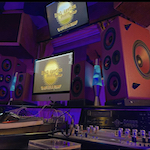Dolby Atmos has changed the way we think about sounds. It has freed sound from the limitations of traditional stereo and channel-based mixes. Instead of using the traditional sound channels, which only placed audio on left, right, up, and down. Dolby Atmos lets you position sounds as objects in a three-dimensional space.
Which helps you enjoy a more immersive experience. Where every element can have its own precise location in the soundfield.
In this blog, we will discuss how you can sharpen Dolby Atmos mixing skills.
Setting Up Your Dolby Atmos Production Environment:
In order to start your Dolby Atmos journey, the first thing you will need is a perfect production environment. Whether you’re working from home or at a professional Dolby Atmos studio Georgia, these fundamentals remain the same.
1. Digital Audio Workstation:
Digital Audio Workstation or DAW is one of the most important parts, you can say the central part of your Atmos workflow. You can choose from popular DAW options like Pro Tools, Logic Pro X, and Nuendo. They provide Dolby Atmos integrated support and make sure that their Daw version perfectly aligns with Atmos production.
2. Dolby Atmos Renderer:
The Dolby Atmos Renderer is a tool that is used for processing the spatial audio information of a soundtrack. Then transfers the information in its required format.
( Read More – Music & Dolby Atmos – How Does 3D Mixing Work? )
A renderer can run on the same machine as your DAW, or you can also use a separate rendering system. Based on your needs and budget, you can choose different renderer options.
3. Audio Interface And Monitoring:
In order to monitor your Atmos mix accurately, you will need a high-quality audio interface with sufficient output channels. The number of outputs will depend on your speaker setup. However, for immersive monitoring, you will need a minimum of seven bed channels.

4. Speaker System:
If you want to make an immersive and informed mixing decision in Atmos. You need to invest in a high-calibrated multiple-speaker system. A common starting point is said to be a 7.1.2 or 7.1.4 configuration. It means seven speakers, one subwoofer, and two or four overhead speakers.
5. Headphones For Binaural Monitoring:
Headphones for binaural monitoring allow you to experience a virtual 3D soundspace through headphones. Which is quite useful for content intended for headphone playback.
Mastering The Tools:
Today, most of the Dolby Atmos studio Atlanta use DAWs with built-in Dolby Atmos support or with plugins. So, it has become important to learn object-based routing techniques, master bus configurations. Especially learning the specifics of your DAW’s 3D panner.
Understand the key differences between beds (for instance, static and foundational sounds) and objects (movable, spatial, dynamic elements). Make sure you practice creating sessions where you use both beds and objects effectively.
Regularly updating your software and learning about new features will help you be on track and keep your workflow efficient.
Monitoring Techniques:
A professional Atmos environment will have multiple speakers. However, most of the producers start off with high-end headphones. So, it is important for you to learn binaural audio renderers in order to first look at the immersive field. And then test your work on different speakers whenever you find possible.
Make sure you check on the stereo and downmixes so that your music mix remains perfectly effective in any format. Furthermore, accurately monitoring also helps you make confident spatial decisions.
Using Spacing and Silencing:
If you get the urge to fill every minute gap with a sound, then unfortunately, this is not how sound production works in Dolby Atmos.
What you can do is assign primary position for the main soundtracks, and keep the side elements airy and unobstructive. Make proper use of delay and reverb, not just as effects but also as distance cues. For instance, use short and dry for closeness, long and diffuse for depth.
Using silence strategically in places will help in heightening your listener’s focus.
( Read More – Dolby Atmos for Headphones )
Movement With Purpose:
The sound movement in the Dolby Atmos mix should feel intentional while a smooth, slow pan adds dimension to sustained sounds. Quick and deliberate pans are used for providing dramatic or high tension to the audio.
Make sure you avoid any type of extensive, excessive, or random audio movements, as this can distract from the main focus element.

Metadata and Delivery Standards:
Different platforms have their own unique requirements for Atmos deliverables. Doesn’t matter whether it is Netflix, Apple Music, Gaming Consoles, or Spotify. Learn their unique specifications and requirements early.
Then, integrate metadata properly so that the spatial intent is perfectly preserved, regardless of the playback system. Staying aligned with the delivery standards ensures that your mix translates consistently everywhere.
Collaboration and Translation:
When you are working in a Dolby Atmos studio Georgia, it is better to share your vision with your team to share your diagrams of the soundfield. But here’s the pro tip- It is better to share both immersive and stereo versions to the client. It will help them better understand how the music mix is going to translate.
Always remember that a fraction of your listeners are going to hear your work in a dramatically reduced format. Effectively collaborating will bridge this gap between creative vision and technical execution.
Managing Phase and Masking:
When many sound sources come from different directions and angles. The risk of frequency masking and phase problems increases. So, use EQ to carve out the space and apply mid-side processing where necessary.
With precise filtering, you can cope with the low-frequency problem and keep your bass tight and powerful. Properly managing everything will ensure clarity even in a dense mix.
Staying Organized:
Dolby Atmos sessions can get quite large and complex. So, make sure you stay organized. Label tracks clearly, group them logically, and use color-coding for quick navigation. Having different types of templates for different kinds of projects is an effective approach that can save a lot of time and reduce technical errors. Organization is the core for staying productive even under tight deadlines.
( Also Read About- How You Can Create Your Own Dolby Atmos Sound? )
Conclusion:
Dolby Atmos offers a 3D environment, blending creativity and technical skills alike. It’s definitely not easy but mastering the 3D soundspace skills comes from consistent experimentation and critical listening.
Practice intentionally, stay organized, and keep your mixes aligned across playback systems. This will help you make the most of the immersive format.

